A Private Tour today, based in North Norfolk. It was a grey and wet morning, but the rain stopped in the afternoon and we had some glorious autumnal sunshine to end the day. The rain didn’t stop us though, and we saw some great birds.
We met in Wells. A Rough-legged Buzzard had taken up residence around the fields between the Beach Road and the west side of town over the last three days, so we thought we would start by looking for that. We had a quick drive up along Beach Road but there was no sign of it looking from there.
As we drove out of Wells towards Holkham, we spotted a raptor on the top of a hawthorn bush, but as we pulled up we could see it was just a Common Buzzard. But then we noticed something large which was hovering over the fields behind it – the Rough-legged Buzzard. We pulled into the car park and as it was not raining now we piled out. The Rough-legged Buzzard was still hovering, and we could see its dark belly contrasting with its very pale head, and its white tail with a wide black terminal band.
The Rough-legged Buzzard flew over towards us, and landed on the top of a bush on the bank north of the car park. We walked up the track to the old sewage works for a closer look, flushing a second Common Buzzard from the trees as we did so, much darker than the Rough-legged. We got the scope on the Rough-legged Buzzard and had a great look at it.
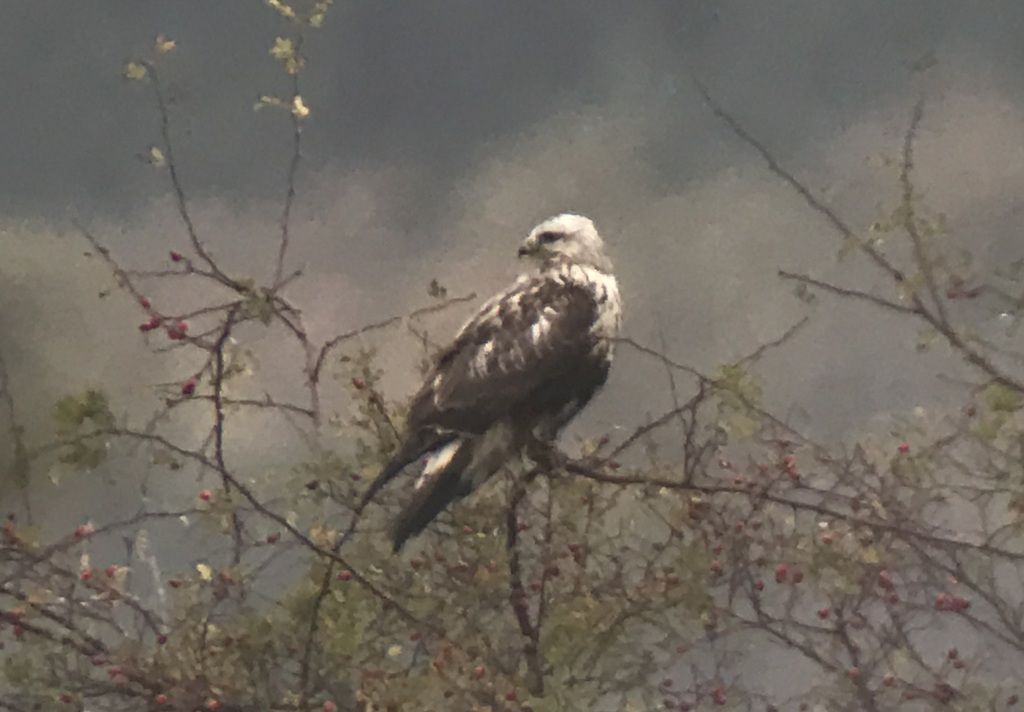
There were lots of other birds here too. A covey of Grey Partridges was in the cover crop in the field next to the track, although they were hard to see. We managed to get one in the scope so we could see its orange face. Several Goldfinch, Chaffinch and Greenfinch were in the bushes, and a flock of Linnets flew round over the field. A drake Pintail flew over.
It started to rain harder again now, so we walked back to the minibus, and drove west, along the coast road to Titchwell. A flock of Long-tailed Tits was working its way through the trees in the car park as we got out and on the walk to the Visitor Centre we stopped to watch a Goldcrest feeding low down in the sallows by the path. There were Goldfinches and Chaffinches on the feeders and a Coal Tit popped in briefly.
Heading out along the main path, there was no sign of any Water Rail in the ditch today – even if the raindrops dripping off the trees into the water made it look like there might be something moving in the bottom. There were a couple of Little Egrets on the former pool on Thornham grazing marsh and as we stopped to look we noticed some movement in the vegetation down near the front, a Water Pipit. Unfortunately, before we could get the scope on it, it flew and landed in some taller vegetation out of view and a minute or so later flew off.
There was a Marsh Harrier over the reedbed at the back of the old pool. As it flew out over the saltmarsh, it flushed several Curlews and Redshanks which flew up calling loudly. A Common Snipe flew out too – we could see its long bill as it circled round. The Reedbed Pool on the other side of the path produced a Tufted Duck in with the Mallards. A Cetti’s Warbler called in the reeds.
We continued on to Island Hide, where we could get out of the weather. There were lots of Golden Plovers roosting on the islands. They were surprisingly well camouflaged against the mud and low vegetation.
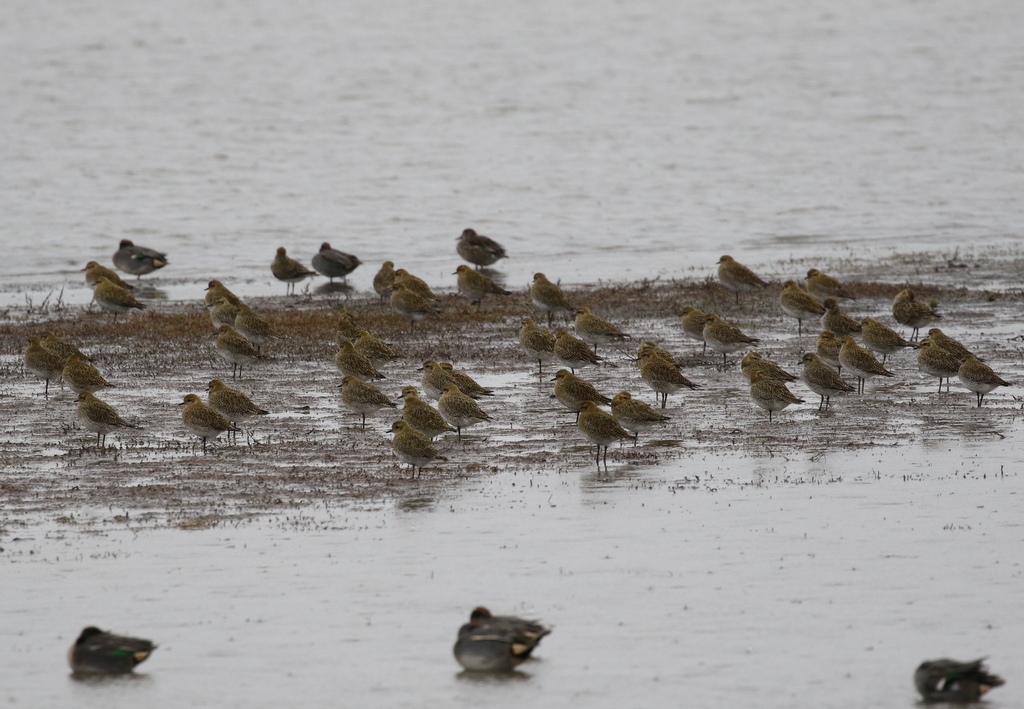
A few much smaller Dunlin were on the edges of the islands. A small flock of Knot flew in and started bathing in the shallow water, and when we got the scope on them, we could see a lone Ringed Plover on the island behind. Further back a long line of Avocets were mostly asleep, standing on one leg. Several Lapwings were on the low island, all facing into the rain with their backs to us.
There were plenty of ducks out on the Freshmarsh too – Wigeon, Teal, one or two Shoveler, and several Gadwall. Small groups of Brent Geese flew in and out from the saltmarsh where they were feeding.
The rain wasn’t too bad, so we carried on round to Parrinder Hide. One or two Reed Buntings were feeding in the vegetation below the path and flew up ahead of us, perching up in the reeds, flicking their tails agitatedly.
When we got into Parrinder Hide, there was another Water Pipit on the island in front. This time, we could get the scope on it and get a better view – white below with well-defined black streaks on the breast, well-marked pale supercilium and off-white wingbars.
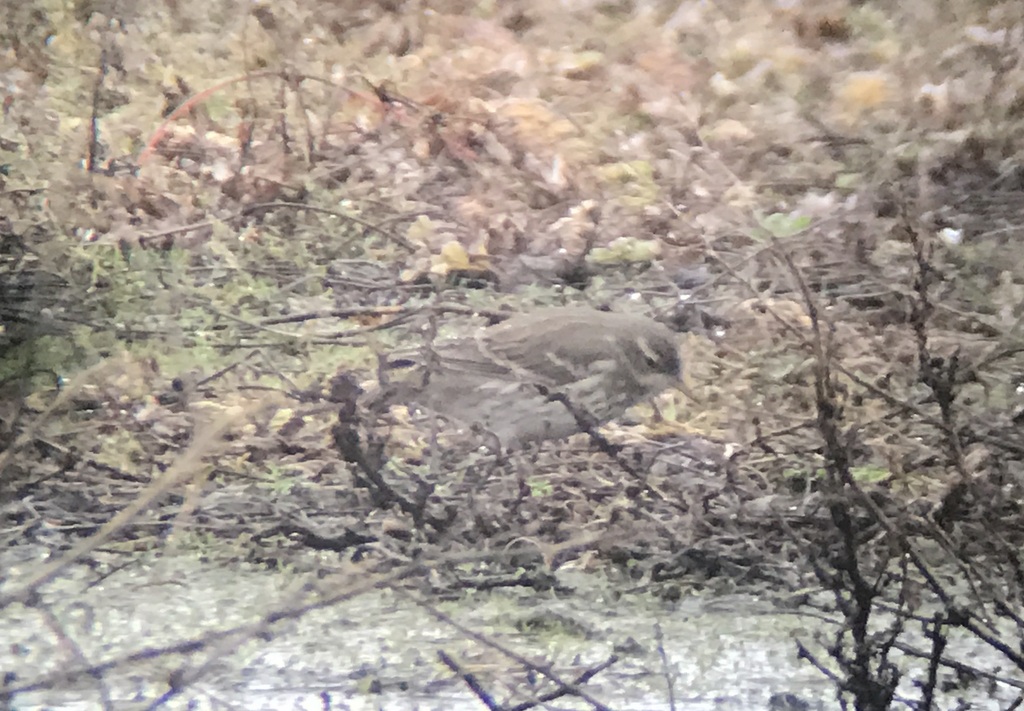
We were closer to the Golden Plover here and, despite the poor light, they looked noticeably golden-spangled on the upperparts. A single Grey Plover appeared on one of the islands behind, much more monochrome.
There were several Wigeon on the islands in front of the hide too – the drakes looking good now, mostly out of drab eclipse plumage, some still with remnants. A few Shelduck were now out with the Gadwall and Avocet in middle. On closer inspection, there was one Pintail with them too.
From round on the other side of Parrinder Hide, we had a look over Volunteer Marsh. There were lots more Wigeon and Teal out here, well hidden where they were feeding in the tall vegetation. A pair of Egyptian Geese flew in too. One or two Grey Plover were out on the mud and several Redshanks were in front of the hide along with a few smaller, dumpy Knot.
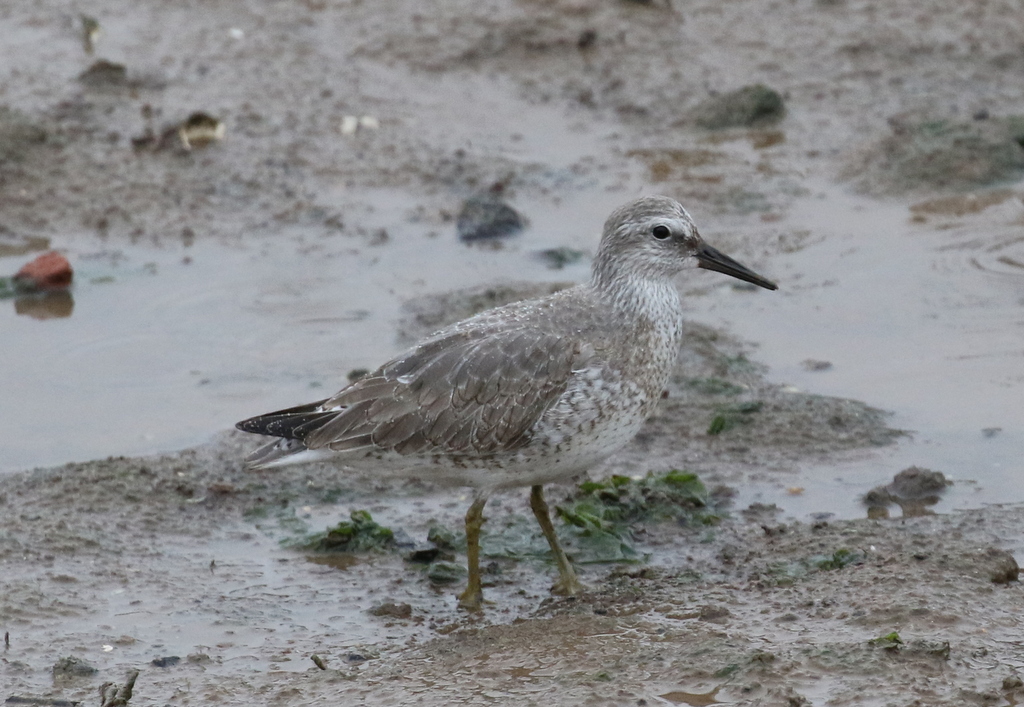
Our hope was that the rain would stop early afternoon, so we went back to the Visitor Centre for an early lunch. Afterwards, we drove back west to Holkham. It was still raining when we arrived, but we could see brightness and blue sky to the south, which was hopefully heading our way.
As we parked on Lady Anne’s Drive, there were a small number of Pink-footed Geese out on the grazing meadow either side – five on one side, two the other. Lots more geese flew in as we got our stuff together – Greylags with their deeper honking, and the Pinkfeet with their higher-pitched ‘ang-ang’ calls, which landed on the grass further back.

Several Jays flew up and down over the trees and, as we walked up towards the pines, we noticed a covey of Grey Partridge out on the grass right behind the parking attendants’ hut.
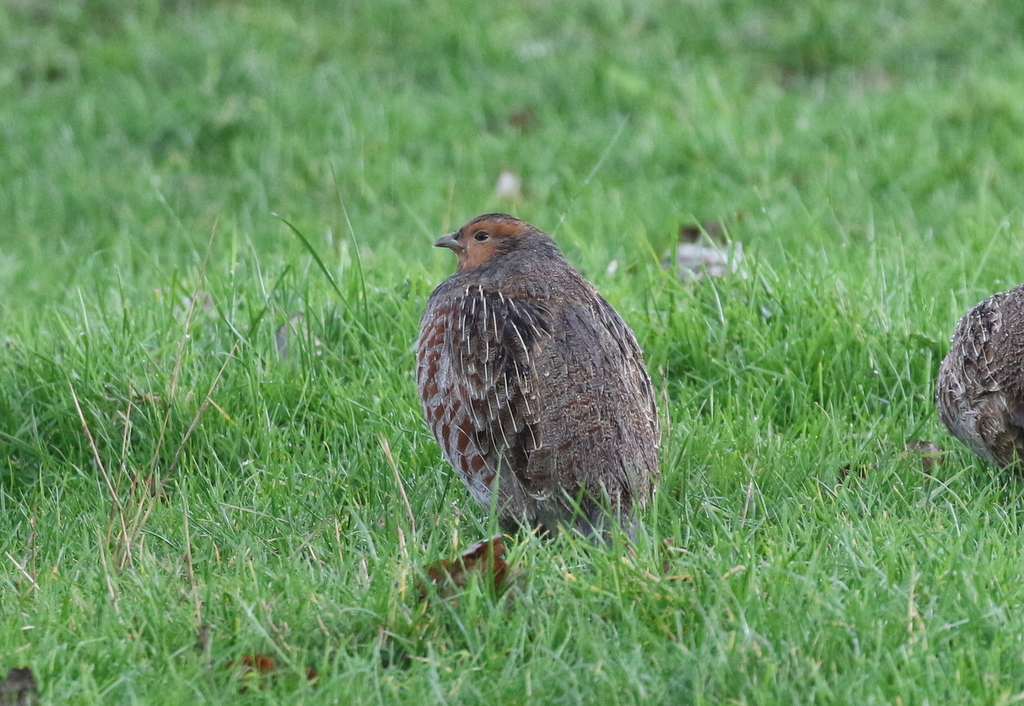
As we made our way out along the edge of the saltmarsh, the sky started to brighten up. There were lots of Brent Geese out feeding in the saltmarsh vegetation and a large flock of Linnets whirled round before dropping back in.
As we got to the cordon at the east end, we saw first another group of Linnets fly up, and then we spotted the six Shorelarks taking off too. We didn’t see what had spooked them, but the Shorelarks flew past out over the dunes, and carried on west. Lots of Skylarks came up from the saltmarsh too now, and we watched them flying round together over the Gap, before the Shorelarks appeared to go down onto the beach over in that direction.
We decided to walk back west along the beach to look for them. As we made our way out past the cordon, we spotted another covey of Grey Partridges in the saltmarsh beyond the fence. A swan coming in over the beach caught the low sunlight, contrasting with the remains of the dark cloud behind – very evocative. It was a lone Whooper Swan, presumably freshly arrived over the sea, coming in for the winter most likely from Iceland, probably heading for the Ouse Washes.
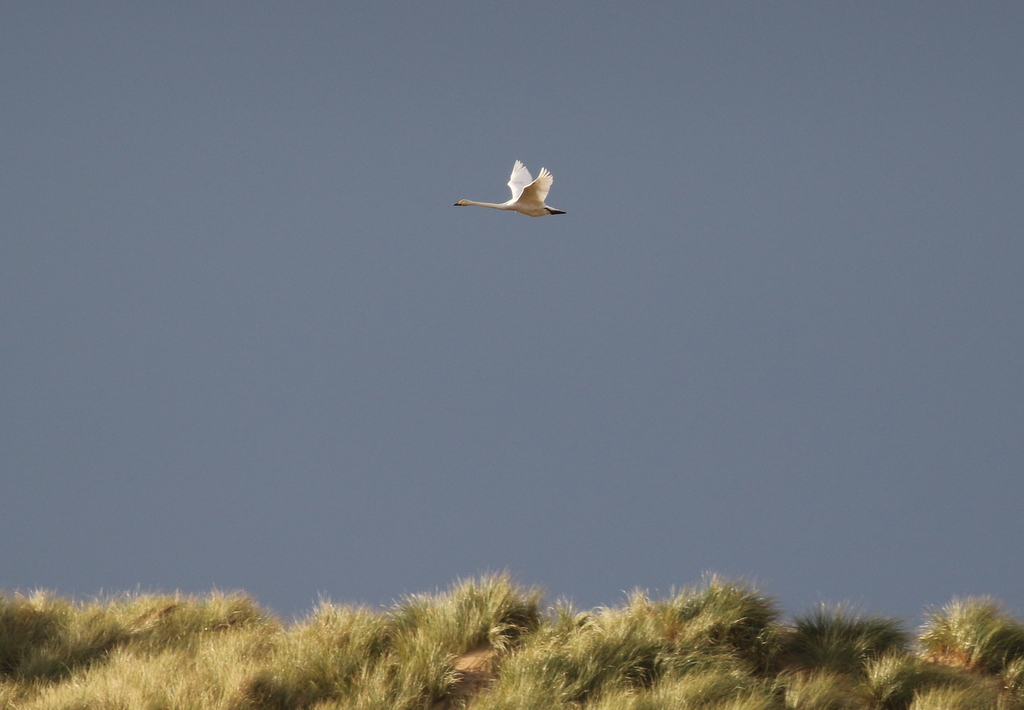
We stopped for a quick scan of the beach, and there looked to be lots going on. Big numbers of gulls and a line Cormorants out on the sand, Oystercatchers scattered between them and small groups of Sanderlings scuttling up and down the shoreline.
We could see a small group of Common Scoter on the sea just beyond the breakers, all pale-cheeked females or immatures. As a few more flew in to join them, we noticed one with white wing patches, a Velvet Scoter. It landed and we got it in the scope, a fraction bigger than the Common Scoters and with a very different face pattern, with two smaller pale spots.
There were five Red-breasted Mergansers just off beach too, and we had a great view of those through the scope. Several Great Crested Grebes were offshore, along with a single Red-throated Diver. Scanning away to the west, we picked up two Slavonian Grebes just offshore a bit further over.
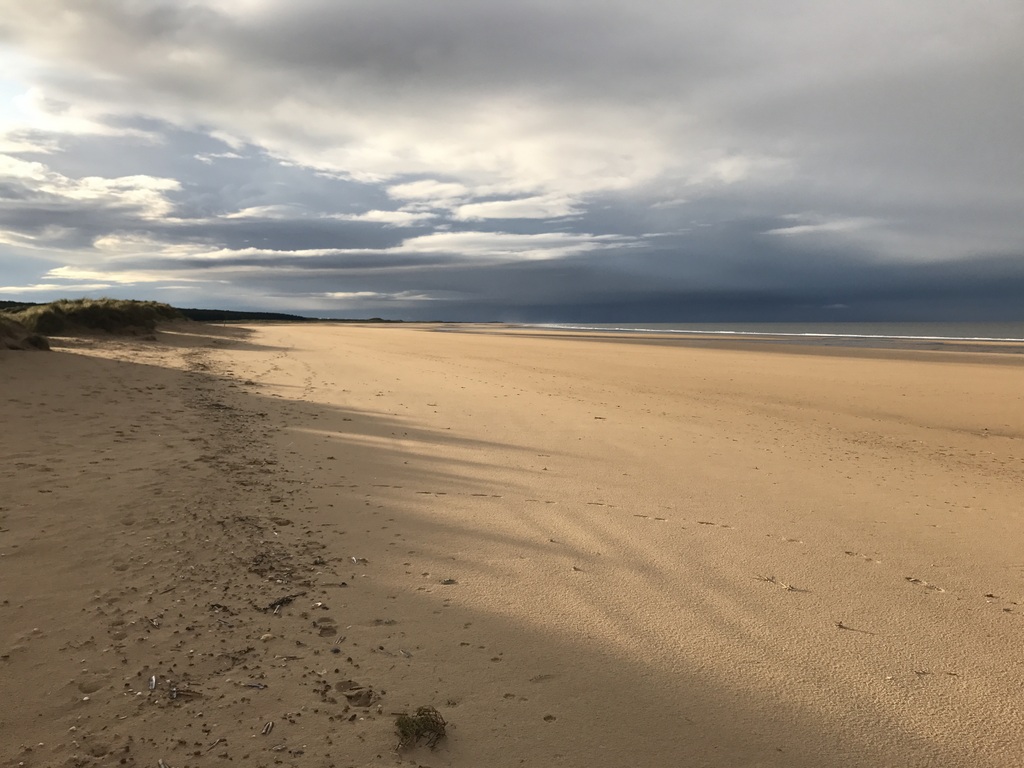
Now the weather had brightened up, suddenly there were lots of people out for a walk, and lots of dogs running around on the sand. Looking back, we still couldn’t see the Shorelarks in cordon, so we walked west along the beach to see if we could find them over where they had landed earlier. A couple of people had just walked through the area and there was no sign now. We knew they regularly return to the cordon, so we walked back to have another look just in case.
When we got back, we found the Shorelarks were indeed back in the cordon, down at the eastern end. We had a quick look through the scope, and then walked round for a closer view. A Ringed Plover was on the saltmarsh ahead of us and a Rock Pipit flew in. It kept flying up and landing next to the Ringed Plover – for some reason it seemed to want to feed close to it.
The Shorelarks had moved out into the middle, and as we walked round to the path on the southern side of the saltmarsh we had a great view of them, their bright yellow faces shining in the low autumnal afternoon sunshine. Great birds!
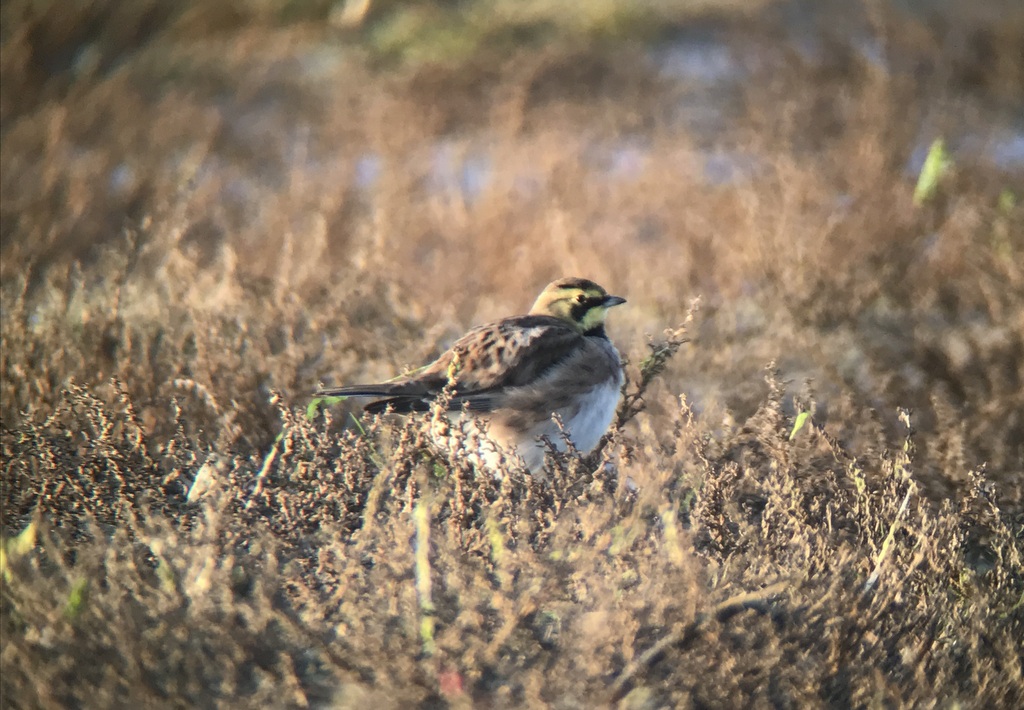
Mission accomplished, we walked back to Lady Anne’s Drive. There were lots of Pink-footed Geese now out on Quarles Marsh, behind the Lookout cafe. A large flock of Egyptian Geese were down on the grazing marsh and as we stopped to look at them we noticed several Brown Hares nearby too.
We drove round to Stiffkey Greenway to finish the day. We were a bit later than planned, after running round after the Shorelarks, and the light was already starting to go. We had apparently already missed a Hen Harrier which had flown past before we arrived.
As we scanned over the saltmarsh, we did find a Merlin perched on a small bush. It was quite a way off, but we could see it in the scope. Someone else pointed out an even more distant Peregrine, perched on a post off on the edge of Blakeney Harbour. An owl was hunting way off out at East Hills, although we could only see it as it broke the skyline now. It looked like a Short-eared Owl, and this was confirmed later by someone who was watching from further west tonight.
More and more Little Egrets started flying past, in small groups, heading off to roost. The light was really going now. It had been a great day, but it was time to head for home.
















